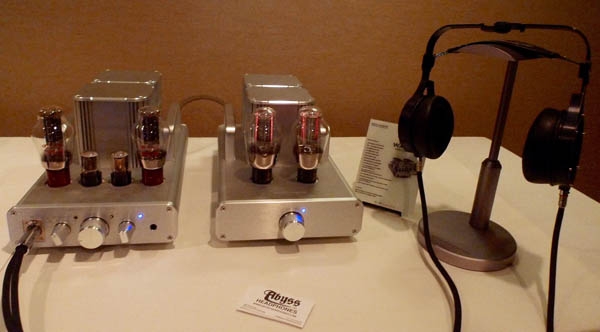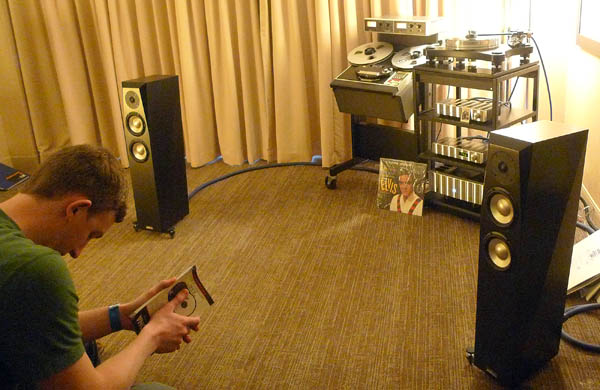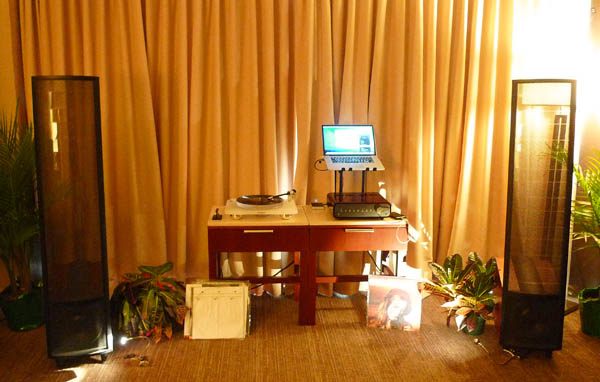| Columns Retired Columns & Blogs |
I purchased SweetVinyl's Sugarcube and named it Bjork!

We could all see through the glass, and Jack Woo had the Abyss AB-1266 earspeakers ($5495) connected to his unique WA5-LE single-ended 300B tube headphone amplifier ($3699). Inviting the oldsters to join me in the room, I selected a 2.8MHz DSD of Willie Nelson's "Georgia" (I figured they were familiar with the tune), and asked them to listen. When they finished, they both had sheepish looks. Well? The Lyra Atlas guy exclaimed, "Most natural sound I've ever heard." I looked quizzically at Dynavector dude: Better than the Schweikert's," I prodded? He replied almost mournfully: "Yep."
They asked me what I thought, so I told them about my dream system: Dohman Helix I turntable ($37,500) with one of Frank Schroeder's arms ($4000-$12,000) and a Tzar cartridge ($10K), plus the Woo Audio WA5 amplifier ($5899 with 8Wpc loudspeaker outputs) driving the DeVore Orangutan 0/93s and Abyss earspeakers. That would be all the hi-fi I would ever require.

I directed my converts—now fully initiated—to Jack Woo's newest and most amazing sonic invention: the brand new WA8 "Eclipse" is a battery-powered, tube-amplified (6S31Bx2 plus 6021x1) portable headphone amp/DAC ($1799-1899). This beautiful machine is a single-ended, transformer-coupled (transformers are wound in-house with nickel-cores and OCC single-crystal copper wire) machine capable of 24/384KHz playback. Bravo, Jack Woo! The world of audio is changing very fast these days.

Speaking of Dynavector cartridges, the estimable Jeff Joseph of Joseph Audio was showcasing his Profile loudspeakers ($7000/pair) using a Dynavector moving-coil to play Elvis's "I Got a Woman." Joseph speakers consistently deliver taut, lively, exceptionally natural sound—but today, with the unabashedly musical (and liquid to the eyes) Jeff Roland electronics, the Joseph Audio sound struck me as even more alive and well organized than ever.
When Mr. Joseph punched Play on his RTR reel-to-reel deck, grain diminished and natural ease increased noticeably. He played Dusty Springfield's "The Look of Love"—it sounded pure and smooth, like fine old brandy. "How long I have waited…"
Twenty years ago I owned a 30ips master tape of the Casino Royale soundtrack, and would play this same song at audio shows on an old Ampex 300 console. Back then, show attendees scratched their heads. They were convinced this was a defunct medium with no hope of competing sonically with the shiny new CDs they wanted me to play after the tape finished. At Axpona 2016, reel-to-reel tape decks were not uncommon. Turntables were more common than music servers. And…surprise, surprise: in every room that played digital, the lighted display always said 44.1. I asked one exhibitor why he didn't opt for higher-rez: "I play what I like and what sounds good," was his reply.

Okay, I admit: I love Klaus Bunge and his high-value Odyssey products. What's not to like? He's a big guy—almost fierce looking—and tells great stories. Visiting his room and watching him pontificate is always a highlight at every show. Best of all, he and his wife, Irina, his son, Alex, and his best friend, Alejandro, make everything he sells, by hand, in America.
I went to the Odyssey room twice; both times I could not get in because of the crowds jamming the hallway, waiting to hear his demo: this poster on his door was as far as I got! I couldn't even see what gear he was demonstrating. (I did get glimpses of his bearded face and wildly waving arms.) Suffice it to say, Klaus and his clan make extremely high-value products that play music like the big-buck stuff.

The first time I heard about people ripping their LPs to digital files, I cringed. What the…? Why would anybody do that? Isn't it better to get our soft asses out of the soft chair and lower a tonearm on to a black disc? Where's the joy and movement and that beautiful crunching sound as the needle hits the lead-in groove? Well today, SweetVinyl's new Sugarcube hi-resolution, all-in-one vinyl-to-digital recording platform went a very long way toward making me a believer. (Everything I mock, I become.)
The Sugarcube ($2000) is a smart-looking little box, into which you insert a USB stick, and its 24/192 A/D and D/A processors create high-quality recordings from your black disks. All you have to do is press one button! If you like (and if you feel strong and able enough), you can press a second button, and the Sugarcube's "real-time click & pop filter" will be engaged.
I sat and listened, comparing the sound of the LP to the sound of the new dead-quiet digital version, and I was deeply and honestly impressed.

Every seasoned audiophile has a special place in their heart for the electrostatically engaging sound of ultralight membranes vibrating between highly-charged stators. We all enjoy the transparency and vivid soundstaging of big see-through dipolar-radiating electrostatic panels—but many of us have been critical about the lack of bass (without an add-on dynamic woofer) and the need to position these speakers far out from the room boundaries. David Janszen shares these concerns, and he believes that his electrostatics-in-a-box deliver all the speed and transparency of traditional ESLs, but without the comb-filtering artifacts, degraded imaging, and poor transient response of traditional panel speakers.
At AXPONA, Mr. Janszen demonstrated his Carmelita Active standmounted models ($7890/pair in active form, $4995/pair in passive) with Princeton professor, art collector, and plasma-rocket-engine designer Edgar Choueiri's BACH-SP system ($54,000 including infrared tracking cameras, microphones, and a dedicated iPad controller), which uses stereo loudspeakers (or headphones) to deliver realistic three-dimensional sound from anywhere in the user's listening room. The BACH-SP uses an infrared camera to track the listener's ever-changing head position, and makes real-time adjustments to compensate for any changes in the listening sweet spot. I have experienced Dr. Choueiri's wizardry on several previous occasions and can swear that it works phenomenally well—as do David Janszen's active loudspeakers.

Who has a better smile and tells a better, more sincere story than David Solomon of Peachtree Audio? Today was the second time I experienced the two new Peachtree integrated amps: the 150Wpc nova150 ($1499) and the 300Wpc nova300 ($2199). Both of these feature-laden amps use ESS Reference 9018K2M Sabre DACs with 32-bit/384kHz PCM and 5.6MHz DSD capability, and have a discrete "custom-designed" headphone amplifier and moving magnet phono stage.

To begin, David demonstrated the nova300 driving the Martin Logan Summit X loudspeakers ($14,999/pair) and the sound was elegant, titillating, and authoritative in the extreme. When he finished with that mighty combo, he demonstrated the nova150 with the modest Elac B6s ($279/pair) that I reviewed. My reaction (as well as everybody else's in the room): "Oh my, oh me—that was not a sonic letdown at all!"

I purchased SweetVinyl's Sugarcube and named it Bjork!